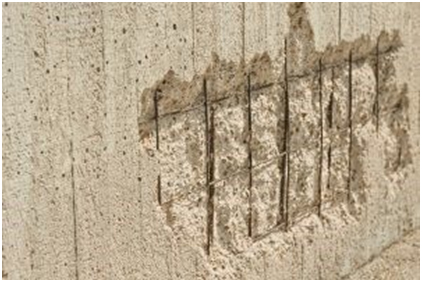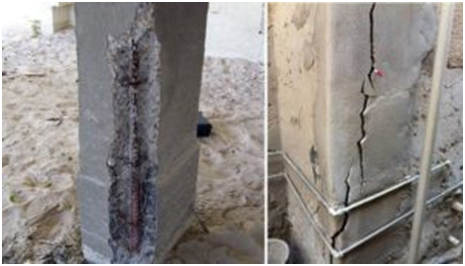Concrete is a man-made stone that helps us to build a structure for improving the way we live and work and for enabling rapid, safe and high-volume transportation. In general, Cement Concrete (CC) is the resultant of cement + sand and stone pieces mixed with water. When concrete is installed with steel reinforcement bars/plates or fibres is called Reinforced Cement Concrete (RCC). Concrete is the major construction item in today’s timeline as this is economical, hardens at normal temperature, easy to cast in required shape and size, temperature resistance is a reusable waste and easy/multi-method of application. But it still needs repair over time.
Why does concrete structure need to repair and maintain?
There are many reasons for deterioration / failure of concrete, ex: Human inflicted (Such as low strength concrete, inadequate concrete cover, poor construction techniques, etc.), Environment related causes (Like, freezing and thawing, early-drying shrinkage, chemical attack, carbonation etc.), External mechanical factors (Like restraints against movement, abrasion, wetting and drying, freezing and thawing, overloading, structural alteration, fire resistance and settlement, etc.), etc.
By all these reasons, concrete starts failing / deteriorating giving alarm for the Repair & Maintenance of Concrete Structures. This includes damage to bridges, buildings, parking structures, environmental facilities, as well as other structures. Unfortunately, repair costs can be staggering. Delaying repairs usually results in much more costly repairs later. Furthermore, if concrete deterioration or damage is not timely addressed, we may need to demolish it permanently. Fortunately, with https://epoxy-resin-flooring.uk, we can provide a strong and long-term solution to combat concrete deterioration and damage
Problems in concrete and how it can be repaired and maintained properly:
Porous concrete surface

Application of Hydrophobic / Impregnations like Deep penetrating sealer or crystalline coating which provides water repellent surface, or Anti-carbonation coating which provides protection from Carbon-Di-Oxide gas. These are the products as per BS EN 1504-2 for Surface Preparation Systems for Concrete – repair and maintenance purpose.
Concrete restoration
When concrete damages, its ability to support the structure will start to decrease, then it is necessary to restore the concrete by repairing old and damaged concrete.


When concrete is about to lose its strength, concrete restoration can be done using non-structural grade repair mortar like: A 45 / CM (Cement mortar) + acrylic admixture / CM + SBR admixture.

When concrete is failed and lost its integrity but still in position, can be repaired by using structural grade repair mortar like B 35 Structural grade, polymer modified cementitious repair mortar, having compressive strength of 49 Mpa and can be applied thickness up to 40-100mm or using B 33, high build, polymer modified cementitious renovation mortar, having compressive strength of 25 Mpa and cab applied at thickness up to 40mm. These are the products as per BS EN 1504-3 for Structural and Non-Structural Repair for Concrete.
While carrying out the concrete restoration, it is necessary to make sure the applied repair mortar is in-tack with the existing surface of the structure. So, it is recommended to use Epoxy bonding agent / SBR bonding agent / Acrylic bonding agent for Bonding of external steel or composites to concrete for strengthening purposes, Bonding of hardened concrete to hardened concrete (precast units) and for Casting of fresh concrete to hardened concrete to form a composite bond. These are the products as per BS EN 1504-4 for Structural Bonding purposes.
Concrete having Honeycomb




Honeycombs in the concrete can make concrete in-capable to take the load. When the load is forced on these honeycomb matrix, concrete can crack. The process of pressure grouting using Cementitious grout or Epoxy injection grouting will fill the honeycombs and cracks and increase the durability and sustainability of the concrete. Open honeycombs at the concrete surface and cracks allow water and chemicals to ingress in the matrix causing a damageable effect to concrete. Open honeycombs (potholes) and cracks, shall be filled using crack filling chemical / Epoxy concrete repair products like EP 305, epoxy-based putty. These are the products as per BS EN 1504-5 for Concrete Injection purposes.
Strengthening of concrete

Because of many reasons, concrete structure fails in taking the load, then the only solution is to strengthen the existing structure by increasing the dimension of the structure by anchoring extra reinforcement using EP 310, Polyester Resin Anchoring Grout or by concrete repair products, B 50, Industrial, high strength, free-flowing epoxy grout and by Micro concreting. These are the products as per BS EN 1504-6 for Anchoring of Reinforcing Steel Bar purposes.
Corrosion / rust

Once water / moisture reaches the reinforcement bars, concrete starts spalling resulting in exposure of bars. Before applying repair mortar, it is necessary to clean and apply 2 coats of EP 410, Epoxy Zinc Rich Primer – Anti corrosive / rust coating. These are the products as per BS EN 1504-7 for Reinforcement Corrosion Protection purposes.
As we all know, prevention is better than cure, it is recommended to use admixture like Integral waterproofing admixture in the concrete, install suitable sized Water swellable bars at construction joints and chose suitable expansion joint treatment i.e., using SU 10, polyurethane sealant or , etc., at the time of casting of the concrete itself.
For more details, visit- https://www.ardexendura.com/

